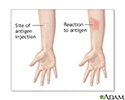CSD skin test
The cat scratch disease (CSD) skin test was once used to help diagnose CSD.
Cat scratch disease
Cat-scratch disease is an infection with bartonella bacteria that is believed to be transmitted by cat scratches, cat bites, or flea bites.

The test is no longer used today. There are better methods available to diagnose CSD, such as antibody detection by the EIA test or bacteria detection by a PCR (polymerase chain reaction) test.
References
Gandhi TN, Slater LN, Welch DF, Koehler JE. Bartonella, including cat-scratch disease. In: Bennett JE, Dolin R, Blaser MJ, eds. Mandell, Douglas, and Bennett's Principles and Practice of Infectious Diseases . 8th ed. Philadelphia, PA: Elsevier Saunders; 2015:chap 236.
-
CSD skin test - illustration
The CSD skin test determines whether or not a person has been infected with cat scratch disease. It is performed by injecting a CSD antigen under the skin with a needle. After 48 to 72 hours the site of injection is evaluated by a physician. If the test is positive the injection site will show evidence of a reaction.
CSD skin test
illustration
-
CSD skin test - illustration
The CSD skin test determines whether or not a person has been infected with cat scratch disease. It is performed by injecting a CSD antigen under the skin with a needle. After 48 to 72 hours the site of injection is evaluated by a physician. If the test is positive the injection site will show evidence of a reaction.
CSD skin test
illustration
Review Date: 5/1/2015
Reviewed By: Jatin M. Vyas, MD, PhD, Assistant Professor in Medicine, Harvard Medical School; Assistant in Medicine, Division of Infectious Disease, Department of Medicine, Massachusetts General Hospital, Boston, MA. Also reviewed by David Zieve, MD, MHA, Isla Ogilvie, PhD, and the A.D.A.M. Editorial team.

